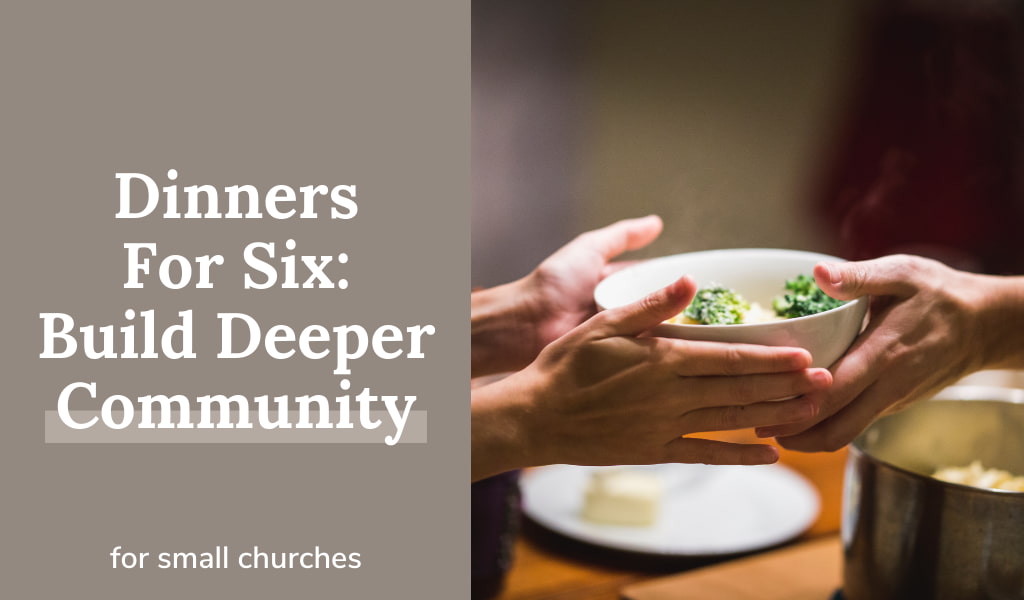This post may contain affiliate links, which means I may earn a small commission from purchased products at no additional cost to you. See my full disclosure here.
Looking to build connections in your small church? Here’s an easy way to organize dinner groups to do just that!
Around the table …
- we hear each other’s stories
- we build trust
- we learn to love better
Dinners For Six
Build Deeper Relationships One Meal At A Time
Connections. Whether making new friends or digging deeper with old friends, meeting over a meal binds people in special ways.
Many of us have great intentions to get together, to reach out, to be more inclusive to those not in the “inner circle” at our small churches. But sometimes our follow-through needs a little help!
Keep reading for a great fix to organize intentional “Dinners for Six” so you can build those relationships you’ve been hoping for.
“Dinners for Six” opened a whole new church experience for me.
I was a senior in college when I was introduced to “Dinners for Six”. Living in a dorm, I was always eager for a home-cooked meal! My fiancé and I added our names to the participation list.
As an introvert, the idea of a more intimate mealtime rather than a bigger crowd sounded appealing!
I wanted to contribute as well, rather than feeling like a mooch, and I appreciated being given an idea of what to bring. I was not a confident cook, but I could sure put together a salad or bring some green beans.
Being a part of “Dinners for Six” opened a whole new church experience for me.
- I treasure stories from dear old saints who’ve since passed on.
- I learned my salvation story was not so different from others.
- I heard about the journey of migrant workers and the struggles they faced to stay employed and take care of their family.
- I learned the backstories behind recent prayer requests.
Names and faces became friends and prayer partners. I remember my “Dinners” companions most.
How To Organize Dinners For Six In Your Small Church
“Dinners for Six” is a simple meal program of rotating companions, locations, and responsibilities each month. Those gifted with hospitality love to host, but don’t limit your outlook. Anyone can step into a hospitality role for one event. Encourage everyone to try it once.
Here is the basic structure for “Dinners for Six”, followed by several variations that are also fun.
What Do Dinners For Six Look Like?
It takes 3 couples, pairs, or family units to fill each dinner group. To include singles, you can split one of the guest responsibilities per single person (as seen in the example below).
Each pair takes one of the following responsibilities for each meal:
1. Host/Main Dish
- Decides on a date and time to meet.
- Provides the main dish.
- Gets the privilege of choosing if it will be an adult-only evening or family-friendly dinner.
- Leads the entertaining/activity based on their group structure.
- Determines any dietary needs of the group and makes them known (dairy/gluten-free, etc).
Some dinner groups enjoy playing a game following a meal, or just enjoying dessert/social time.
2. Salad & Rolls
This is a great introduction spot for new people, as it is easy to purchase a pre-made salad and dinner rolls or choose to make them.
3. Veggie & Dessert
Again, not a difficult option if people are comfortable purchasing a fun dessert or having fun creating a new recipe.
Get Started With Your Small Church Dinner Groups
As you ask about those who’d like to participate, you also want to know who is willing to serve as a host. Create a signup sheet to include phone numbers and the option to serve as the host.
Make it clear they are not signing up to host every single time, but on a rotating basis.
Dinners For Six Works Great On A 3-Month Rotation
My preference is to schedule out dinner groups 3 months at a time, so I can rotate hosts around, and they can take turns.
Agricultural communities have a different flow for busy seasons, but I tend to run my “Dinners for Six” groups during the school year months, combining November/December as one rotation for the busy holidays.
If you don’t have enough hosts to rotate a full 3 months, approach those who’ve registered to participate and ask if they would host the third month. Some will say yes! If no one steps forward, suggest one of the variations for a group listed at the end.
When you have a list of participants, you can create a 3-month schedule. Hand out each month one at a time, so guests will only need to think about the current month.
Sample Dinner Groups Schedule
In the sample below, we have enough people for 3 separate “Dinners for Six” groups! Take a look at how this works! Here is what a one-month rotation might look like:
September Dinners for Six:
| *Dave and Jan | 555-1212 | Main Dish |
| David and Debbie | 555-1213 | Salad and Rolls |
| John and June | 555-1214 | Veggie and Dessert |
| *Bill and Dee | 555-1215 | Main Dish |
| Jeff and Leigh | 555-1216 | Salad and Rolls |
| Matt | 555-1217 | Veggie |
| James | 555-1211 | Dessert |
| *Ben and Nancy | 555-1221 | Main Dish |
| Christy | 555-1222 | Salad |
| Jenn | 555-1224 | Rolls |
| Mark and Pam | 555-1223 | Veggie and Dessert |
*The asterisk marks our designated host for this month. Hosts, please reach out to your Dinner Mates to set a time early on in September so everyone can get the date on their calendars! Hosts get to decide if this is an adult-only evening, or if it is “family night”. Welcome to the table, and have a great dinner!
How To Include Singles: There’s no need to turn “Dinners for Six” into a couples-only program! This is a great opportunity to include singles, and I hope you have at least 4 so they can rotate with each other as well. Simply break up either salad and rolls or veggie and dessert in a given month.
The following month, move hosts either down to salad and rolls, or veggie and dessert, and move someone else to the host spot. Sometimes 2 out of 3 couples will be together again.
Dinners For Six FAQs:
What if there aren’t enough people to fill the schedule?
Sometimes there aren’t enough guests to fill in each spot fully. Consider this an opportunity! The host gets to choose a couple to invite for the evening. It’s a great time to include a new family in the church, or perhaps a friend or neighbor they would like to get to know better.
Why does everyone bring a dish?
Most people feel better coming to dinner when they have the chance to bring something to share. When I leave a blank spot, I leave an empty line and include under the instructions that it is the hosts’ privilege to fill that spot.
You can generally leave that open in the salad and rolls slot. The host can offer the guest to bring either salad, rolls, or both.
What if someone doesn’t want to host?
There are a variety of reasons people are reluctant to host. Cleaning the house is a big one! Sometimes space is also a genuine concern. Here are a few ideas to give them an option:
- Eat outside if the weather is good. Ask guests to bring along chairs.
- Meet at a restaurant.
- Use the fellowship hall at church for your group.
Sharing Meals Builds Relationships
Sharing a meal builds relationships and connections in your small church. It is a great way to include new and/or uninvolved people, build strong friendships, and discover gifts, talents, and abilities in your church that were hidden behind shyness or simply lack of knowledge.
Who would you like to connect better within your church? Maybe it’s time for dinner!
Food brings people together on many different levels. It’s the nourishment of the soul and body. It’s truly love.
Giada De Laurentiis
Read More


I love this idea! Question, is this a once a month dinner? Or an every week dinner?
Hi Judy! When we did a similar program in my church, it was monthly dinner! Once a month was do-able for us!
Once a month is the intention! Also a great reason to clean the house. I always need an extra incentive to dust!
Our small church just began this program – we’ve any of us yet to meet but I’m sure we have great cooks among us, if our potlucks are anything to compare it to. Best of luck and keep up your great site – Shirley
Thank you so much for your comment! We love hearing from our readers! So happy to have you in our community!
We have something called Table Talk groups. This has been going on for a couple of years now. We do as your blog suggests, everyone bringing part of the meal. My husband and I are hosts and another couple are the facilitators. There are 8 of us who gather for a meal and a study/discussion based on something provided by our Pastor. This usually comes from his sermon the previous Sunday. Normally the gatherings are for 6-7 weeks with a break, however, our group has become particularly close and we just keep going. Doing those times, we do different things. For instance, we are currently watching or rewatching for some of us, “The Chosen”. Really good discussion following these. And much spiritual growth. Dinner for 6 / Table Talk, wonderful opportunities for God to be welcomed and responded to.
Carol – I love this! A little more interaction and digging deeper from Sunday. What a great way to work at application and not just sitting and “consuming” at church.
Love this idea! Question: Do you keep the same people together each month for three months or do you shake it up and mix the people into different groups each month?
Samantha, I set it as a sign up for 3 months at a time, and shake up the groups so more people can get to know each other. Some people are hesitant to sign up for the full 9 months – depending on their busy seasons – calving, harvest, etc…
I am very enthusiastic about trying this with our small church.
Thank you Debbie
Awesome! If you’re on Facebook, come join our community! We would love to know how it goes and support you more! Here’s the link: https://www.facebook.com/groups/CreativeLittleChurch/